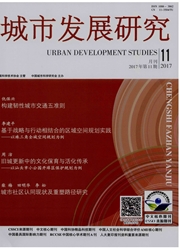

 中文摘要:
中文摘要:
从区域产业关联及其分工合作角度出发,对京津冀区域产业协同网络及其优化策略进行研究,促进区域内分工合作更紧密,布局更合理,推进京津冀区域协调发展。首先运用"产业空间联系强度系数"度量京津冀三大板块及各市之间的产业关联程度及其分布规律,得出在2001-2014年间,京津冀区域各城市间产业联系强度总体呈增长态势,环京津区域始终是发展核心区;各市间产业联系强度差异悬殊,中部地区关联较强,且强关联城市呈规律性分布。其次,运用"产业结构相似系数"、"区位熵"等工具对以上结果的原因进行了分析。最后,将各市的主导产业与对外产业联系强度结合分析,提出京津冀的产业协同优化策略,并提出"中心区—主轴线"发展、交通建设、人才引进、机制完善等政策建议。
 英文摘要:
英文摘要:
This paper focuses on the industry coordinating network and its optimization path of Jingjinji Region (JJJ) from the perspective of inter-industrial linkage, division and cooperation, to make the regional industrial distribution more rational, and thus promote regional coordinated development. Firstly, " Spatial Industry Contact Intensity" was used to measure the level of industrial relations between municipalities and their distribution mode. It was suggested that the overall contact intensity had grown during 2001 and 2014, and the region around Beijing and Tianjin has always been the core area of development. It was also showed that cities where industrial correlations were intensive and distributed regularity and mainly in the central region. Secondly, " Similar Coefficient of the Three-Industrial Structure" and " Location Entropy Evaluation" were used to analyze the factors of the industry collaboration situation in JJJ. Thirdly, " Index of Diversification" was used to measure the diversification level of the 13 cities respectively, combining the cities' leading industries with their " Spatial Industry Contact Intensity" with other cities together, to figure out the industry cooperation mechanisms between the cities. Finally, pole-axis development model, transportation construction and some other policies were suggested as further policy recommendations to promote coordinated development.
 同期刊论文项目
同期刊论文项目
 同项目期刊论文
同项目期刊论文
 期刊信息
期刊信息
